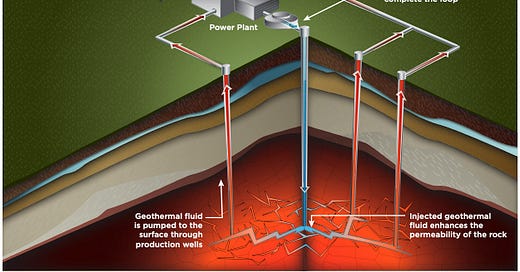Geothermal Weekly - #1
Fervo begins new project in Utah, proposed German policy to fast-track Geothermal development, China leveraging geothermal energy for electricity, heating, and helium
🌎 Fervo Energy’s Utah Project Secures Federal Approval for Enhanced Geothermal Systems
What’s happening: In this past October, the Bureau of Land Management (BLM) approved Fervo Energy’s Cape Geothermal Power Project in Utah, which is expected to generate up to 2 gigawatts of baseload power using advanced enhanced geothermal systems (EGS) technology by 2028. Unlike traditional geothermal, EGS can harness energy in non-volcanic regions, expanding geothermal’s reach.
Why it matters: EGS technology represents a transformative step for geothermal, making it viable in regions without hydrothermal activity. Already seeing success with a pilot project for Google’s Nevada data centers in 2023, this is another step in the right direction.
By the numbers:
2 GW: The anticipated capacity of Fervo’s Utah project, enough to supply power to over 2 million homes.
< 4 GW today: The current geothermal capacity in the U.S., meaning Fervo’s project alone could significantly boost geothermal’s role in the national energy mix.
The big picture: EGS technology could help make geothermal a cornerstone of U.S. renewable energy, offering consistent baseload power that complements intermittent solar and wind sources. This approval signals increasing federal commitment to geothermal and positions Fervo as a leader in the next generation of energy technology.

🔥 Germany Fast-Tracks Geothermal: Utilities Back Acceleration Act
What’s happening: German utility companies are rallying behind the proposed Geothermal Energy Acceleration Act, which aims to streamline approval processes for geothermal projects, particularly in high-energy regions like the Upper Rhine Valley. Utilities such as EnBW and Stadtwerke see the act as pivotal to meeting Germany’s renewable energy goals as it moves away from coal and nuclear power (see bottom three categories in chart below).
Why it matters: Germany’s transition to renewable energy sources demands reliable, baseload power options, and geothermal is uniquely positioned to meet this need. By removing bureaucratic barriers and accelerating project timelines, this legislation could serve as a model for other European countries aiming to expand their geothermal energy production.
By the numbers:
10 TWh target: Germany aims to increase geothermal energy production to 10 terawatt-hours by 2030, a tenfold rise from 2021 (217 GWh for electricity generation; 1,800 GWh for heat generation). Currently, Germany is targeting to increase the number of geothermal plants from 42 in 2022 to 54 plants by 2030.
300 TWh potential: Geothermal energy could meet over a quarter of Germany's heat demand, with an estimated 300 terawatt-hours of capacity available.
The big picture: The Geothermal Energy Acceleration Act aligns with Germany's climate neutrality goal for 2045, showcasing geothermal’s viability as a consistent power source. Streamlined approval processes could make Germany a leader in European geothermal energy, and other countries may look to this policy for guidance in renewable energy development.
Challenges ahead: Utility companies advocate for further improvements, including expanded funding, clearer permitting processes, and community engagement to address public concerns and ensure sustainable project success.
What’s next: German lawmakers aim to finalize the Geothermal Energy Acceleration Act in early 2025. As consultations continue, utilities are expected to provide additional input on practical aspects of the legislation.
🇨🇳Sinopec’s First Geothermal Power Production Pilot Project Connects to Grid
What’s happening: Sinopec, China’s state-owned oil and gas giant, has successfully connected its first geothermal power production pilot project to the grid. The pilot project, located in Xianyang in the Guanzhong region, this project not only uses advanced geothermal technology for heat and power generation but has also proven instrumental in extracting helium, a critical resource with significant economic and industrial applications
Why it matters: Helium, essential for a range of technologies from medical imaging to semiconductor manufacturing, has been in short supply globally and is heavily imported by China to address the high demand. By co-producing helium with geothermal energy, Sinopec is addressing an economic and political need while contributing to China’s renewable energy goals. This dual benefit underscores the strategic importance of the project.
Economic boost: The extraction of helium from geothermal operations provides a lucrative byproduct, helping to offset operational costs and diversify revenue streams. Given helium’s importance to sectors like healthcare and technology, this development could strengthen China’s economic position in critical markets.
By the numbers: (helium)
11% of global helium consumption: China’s helium consumption accounts for 11% of global helium consumption. Though this growth rate has decreased to 4.4% in 2021 from a peak of 13% in 2018, the COVID-19 pandemic played no small role in this change.
0% from US imports: The chart below shows how China’s helium consumption has changed between January 2022 and May 2024. Note the decreased reliance on western helium supplies, increased supply of Russian imports, and overall decreasing helium imports and price. Further domestic production is likely to help this trend.
The big picture: With China aiming for carbon neutrality by 2060, projects like Sinopec’s Xianyang are crucial for achieving a more sustainable and self-sufficient energy infrastructure. Geothermal energy not only provides consistent, renewable power but also offers additional benefits, such as resource extraction, that enhance economic resilience.
What’s next: Although the initial progress is exciting, there is still a long road ahead. Expanding geothermal energy production requires significant investment in drilling and engineering research in addition to the high costs required for developing higher temperature and pressure systems. With new research coming out of the Fushen-1 geothermal exploration, Sinopec is showing strong commitment to development of geothermal as a viable energy resource.
Thank you for reading the first issue of The Geothermal Energy Newsletter!
Make sure to subscribe to get next week’s update!
Thank you so much,
Frank






